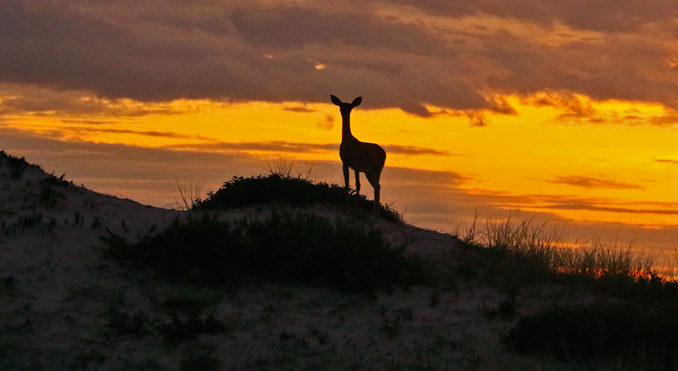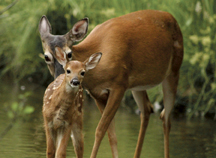
Oh Deer, What Have We Done?

I thought this was as good a time as any to get this topic back on the table for an updated discussion, then let it go back to rest. No matter how much you try to avoid the discussion, the subject of our beautiful White Tailed Deer has literally divided our community into three main groups; those that love the deer and wish they would be left alone, those who hate the deer and wish they’d be exterminated from the East End, and lastly there are those who like the deer however, they believe there are too many in our area and something needs to be done.
Now I won’t elaborate on the first two groups because it’s clear, one side loves, the other hates. These two ends of the moral spectrum have plagued our planet since  the beginning of time and remains the catalyst of anger and wars to this very day. I can’t imagine anyone not agreeing, that hate and death is certainly not a moral or necessary component to a successful solution. With that said, let me talk a bit about the deer, and maybe I can make things a bit clearer for the folks in the third group.
the beginning of time and remains the catalyst of anger and wars to this very day. I can’t imagine anyone not agreeing, that hate and death is certainly not a moral or necessary component to a successful solution. With that said, let me talk a bit about the deer, and maybe I can make things a bit clearer for the folks in the third group.
 Let us start with the deer population. I grew up in Amagansett during the 60’s and 70’s, when seeing a deer wasn’t as common however, open and undeveloped land (aka, Deer Habitat) was abundant, and deer hunting was more popular. Fast forward 50+ years and those same open lands are now filled with residential and commercial layouts, while the NYSDEC have increased their fees for licensing, and amended restrictions have left traditional hunting less appealing. This all adds up to deer herds filling small pockets of available habitat creating the illusion of their increased population.
Let us start with the deer population. I grew up in Amagansett during the 60’s and 70’s, when seeing a deer wasn’t as common however, open and undeveloped land (aka, Deer Habitat) was abundant, and deer hunting was more popular. Fast forward 50+ years and those same open lands are now filled with residential and commercial layouts, while the NYSDEC have increased their fees for licensing, and amended restrictions have left traditional hunting less appealing. This all adds up to deer herds filling small pockets of available habitat creating the illusion of their increased population.
 Add in the hundreds of miles of illegally installed deer fencing that forces the deer to traverse these small pockets via our road sides, and what you have is the results of failed wildlife management, as well as planning and code enforcement. I’m NOT pointing my finger at our present Town departments and committees for creating this problem as this ball was dropped decades ago but, it is their responsibility to correct it, and in my humble opinion they are going about it all wrong.
Add in the hundreds of miles of illegally installed deer fencing that forces the deer to traverse these small pockets via our road sides, and what you have is the results of failed wildlife management, as well as planning and code enforcement. I’m NOT pointing my finger at our present Town departments and committees for creating this problem as this ball was dropped decades ago but, it is their responsibility to correct it, and in my humble opinion they are going about it all wrong.
We need to add another burden to this equation, moving vehicles. Remember, humans are to blame for pushing these animals into small available locations while deer habitat continues to decrease. Humans are also responsible for training these deer to travel along the road sides, due to poor fencing management and an almost complete lack of required wildlife corridors. Now throw in speeding vehicles where the human driver has complete control of their vehicle and the speed of travel, and the police who have a duty to enforce the limits. All these human elements that are clearly impacting the deer, yet some how it’s the DEER who are the bane of our existence.
Are you ready? I’m going to tell you how to MAKE THE DEER ISSUE, LESS OF AN ISSUE. It’s not that difficult, and more importantly nothing has to die. This is not advice to individuals, it’s a partial solution for the Town. Send out a press release asking folks to kindly make any necessary adjustments to their fencing to bring their installation to code. Place the burden on the homeowners who are not in compliance and give them the opportunity to correct their fencing. It also takes the pressure off Code Enforcement who will simply designate one or two officers to insure properties are fenced properly, while helping others become compliant.
At the same time, and this is key, you create wildlife corridors on as many blocks as possible. Every block in the entire Town has a wildlife friendly homeowner living on it. These folks, as well as vacant lots or new construction, can aide in the solution tremendously by allowing a 10′ corridor to exist between two neighboring properties. Corridors and fencing alone will dramatically reduce the road side gathering of deer. It’ll allow them to travel through corridors rather than around via road sides. The deer will prefer the added habitat and they will avoid the busy road ways.
And those deer crossing signs with vehicle collision data totals that increase each year? How about posting something useful rather than fairy tale totals incompletely combined by the Town’s own Wildlife Management Committee (a.k.a. Deer Management Committee). I suggest a deer crossing sign with the additional message of “REDUCE SPEED”. No fictitious information, just a simple instruction that addresses the other, equal element of a vehicle / deer collision,… the vehicle. Remember, the driver has full control of his or her actions while operating a motor vehicle, while the deer has no knowledge of navigating paved roads and obstructed landscapes impacted by human change. Solution: I’m well aware of our awesome police departments heavy work load, particularly during the summer months; however, it would be beneficial to the overall solution to heighten enforcement and fines for speeding through “marked” heavy deer crossing areas
As far as the hunting element of the management issue, I’m neither qualified or interested in commenting. I do however feel the forces of all opinions on the matter COULD come together IF, and only if, they began the dialogue by respecting each others feelings on the issue.
I do want to end this shortened summer piece with a very important informative. Please spread this information far and wide. Mother deer (a Doe) will often drop (give birth) to her young (of 1 to 3) in some unique locations. This could be next to a pool or filter system, back patio, roadside or even right in front of your door. Mom will then instruct the baby to remain still and quiet until she returns for feeding. This could take anywhere from 8 to 16 hours, but mom never really goes too far away and usually can be seen sitting close by if one looks hard enough.
This is a completely normal instinct reaction to most newborn ungulates. Because the fawn has little scent and is still too weak to flee from danger, mom will attract any potential predators with her scent until the baby can stand and walk. Many people who find these motionless fawns tend to assume they are abandoned or even dead. Too often, these folks think they are helping by removing the fawn and taking them to a rehab facility or even worse, try to care for them at home. We absolutely need to reach everyone in the community and let them know to leave these fawns alone.
If the fawn is obstructing a walkway or vehicle passage, it is okay to carefully move the baby off a road or to the side of the walkway. Touching the fawn will not deter mom from returning to her young; however, I do recommend wearing gloves. Here are the few circumstances when you should call me or a wildlife rescue facility for a possible abandoned fawn:
1) The fawn is wandering and CRYING and mom does NOT respond.
2) The fawn is covered with ants, flies, ticks or maggots.
3) The fawns ear tips are curled (this indicates dehydration)
4) The fawn is near a dead adult doe/ or adult doe is dead nearby.
5) The fawn is clearly injured.
6) The fawn is wet (indicates dew on an unattended fawn)
7) The fawn remains in the same spot for 10+ hours (call a rehab facility)
WILDLIFE MATTERS FOLKS – I wish them and you a wonderful SUMMER!!!
~ Dell Cullum
Hampton Wildlife 631-377-6555
Evelyn Alexander Wildlife Rescue & Rehab 631-728-WILD
Oh Deer (Humane Deer Treatment) 631- 604-7072

